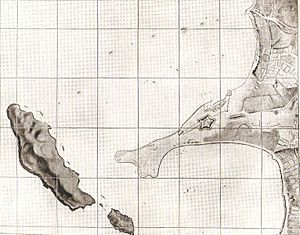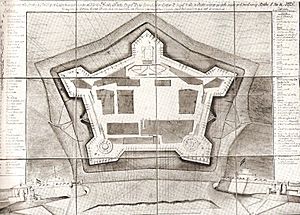Second siege of Callao facts for kids
Quick facts for kids Second siege of Callao |
|||||||||
|---|---|---|---|---|---|---|---|---|---|
| Part of the Peruvian War of Independence | |||||||||
 The port of Callao in 1826 |
|||||||||
|
|||||||||
| Belligerents | |||||||||
| Commanders and leaders | |||||||||
| Land army: Blockade army: |
|||||||||
| Strength | |||||||||
| Bolivarian forces: 4,700 soldiers (half of them Colombians) Naval force: 1 schooner brig 2 frigates 2 corvettes 3 brigs 3 gunboats 171 guns 914 crew |
Royalist army in Callao: 4,000 refugees |
||||||||
| Casualties and losses | |||||||||
| 177 casualties during combat 2,500 casualties outside of the fortress Several dead due to disease |
767–785 killed in action 1,312 dead due to disease Total: 6,000 dead (including civilians) 14 deserters 80 surrendered |
||||||||
The second siege of Callao was a very long battle during the Spanish American wars of independence. It happened at the port of Callao in Peru. In this siege, soldiers fighting for independence from Gran Colombia and Peru surrounded the Real Felipe Fortress. Inside the fortress were royalist soldiers who were loyal to Spain. They refused to give up, even after a big battle called the Battle of Ayacucho had already ended the main war.
The siege lasted a long time, from December 5, 1824, to January 23, 1826. When the royalist stronghold was finally defeated, it marked the end of the Spanish Empire's control in South America.
Contents
Why the Siege Happened
During the Peruvian War of Independence, the capital city of Lima was taken by independence forces in July 1821. The Spanish leader, called the Viceroy, left Lima. General José de San Martín then declared independence of Peru. His troops also took control of the important Real Felipe Fortress in Callao.
After San Martín left Peru in 1822, the soldiers in Callao faced many problems. They didn't have enough food or clothes. There were also political fights among the new Peruvian leaders. This made the soldiers' situation very difficult.
The Callao Mutiny
Because of the bad conditions, some soldiers in Callao rebelled on February 5, 1824. This event is known as the Callao mutiny. Many soldiers who were supposed to be fighting for independence switched sides and joined the royalist army.
After this mutiny, royalist forces took control of Lima again for a short time. They put Brigadier José Ramón Rodil in charge of the Callao fortress.
Later in 1824, the independence armies, now led by Simón Bolívar and with help from Gran Colombia, started winning many battles. They won the Battle of Junín in August 1824. Then, in December, they won the very important Battle of Ayacucho. After this battle, the main Spanish army surrendered. But General Rodil in Callao refused to give up.
The Long Siege Begins

After the Spanish army left Lima for good, many people who were loyal to Spain fled to Callao. They hoped to be safe inside the fortress. Callao quickly became crowded with over 8,000 refugees, along with about 4,000 royalist fighters led by General Rodil.
Even though Rodil knew the main Spanish army had surrendered in January 1825, he still refused to give up. He hoped that Spain would send more soldiers to help him, but they never did.
Fighting the Fortress
To force Rodil to surrender, the independence army surrounded Callao. This army was mostly made up of soldiers from Colombia and Peru. They were led by Venezuelan General Bartolomé Salom. They constantly fired cannons at the port.
From the sea, ships from Chile, Colombia, and Peru also attacked the fortress. These ships were led by Chilean Admiral Manuel Blanco Encalada. The fortress, however, had strong cannons to fight back against attacks from the sea. Its thick walls also made it very hard for soldiers to attack from land. This strong defense and the determination of the royalist soldiers made the siege very difficult and long.
Life Inside the Fortress
Life inside the fortress during the siege was extremely hard. There were too many people, and not enough food or supplies. Food became very expensive, and people started eating unusual things like horse meat. Eventually, they even ate rats because there was nothing else.
Diseases spread quickly because of the lack of food and poor hygiene. Many people became sick and died. General Rodil was very strict. He punished anyone who tried to rebel or leave. He even ordered poor civilians to be forced out of the fortress to save food for his soldiers. However, the independence army would not let these civilians pass, and the royalists would not let them back in. Many civilians died in the area between the two armies.
The End of the Siege
By early January 1826, the situation inside the fortress was desperate. Soldiers were starving, and ammunition was running out. Some royalist officers even switched sides. This made it almost impossible for Rodil to continue defending the fortress.
Finally, negotiations began on January 11, 1826. The siege officially ended when the fortress was handed over on January 23. Only about 400 soldiers out of 2,800 survived. Many civilians had died, and the remaining survivors left for Spain.
General Rodil was allowed to leave with honor, taking some flags with him. Even though he had fought against them, Simón Bolívar admired Rodil's bravery. He said, "Heroism does not merit punishment. How we would applaud Rodil if he were a patriot!"
After the siege, some Peruvian military units were renamed "Callao" to honor their bravery. The Real Felipe Fortress was also renamed the Independence Fortress. This name had first been given to it by General San Martín in 1821.
See also
 In Spanish: Segundo sitio del Callao para niños
In Spanish: Segundo sitio del Callao para niños
- Spanish American Wars of Independence
- Battle of Ayacucho
- Siege of Callao (disambiguation)

